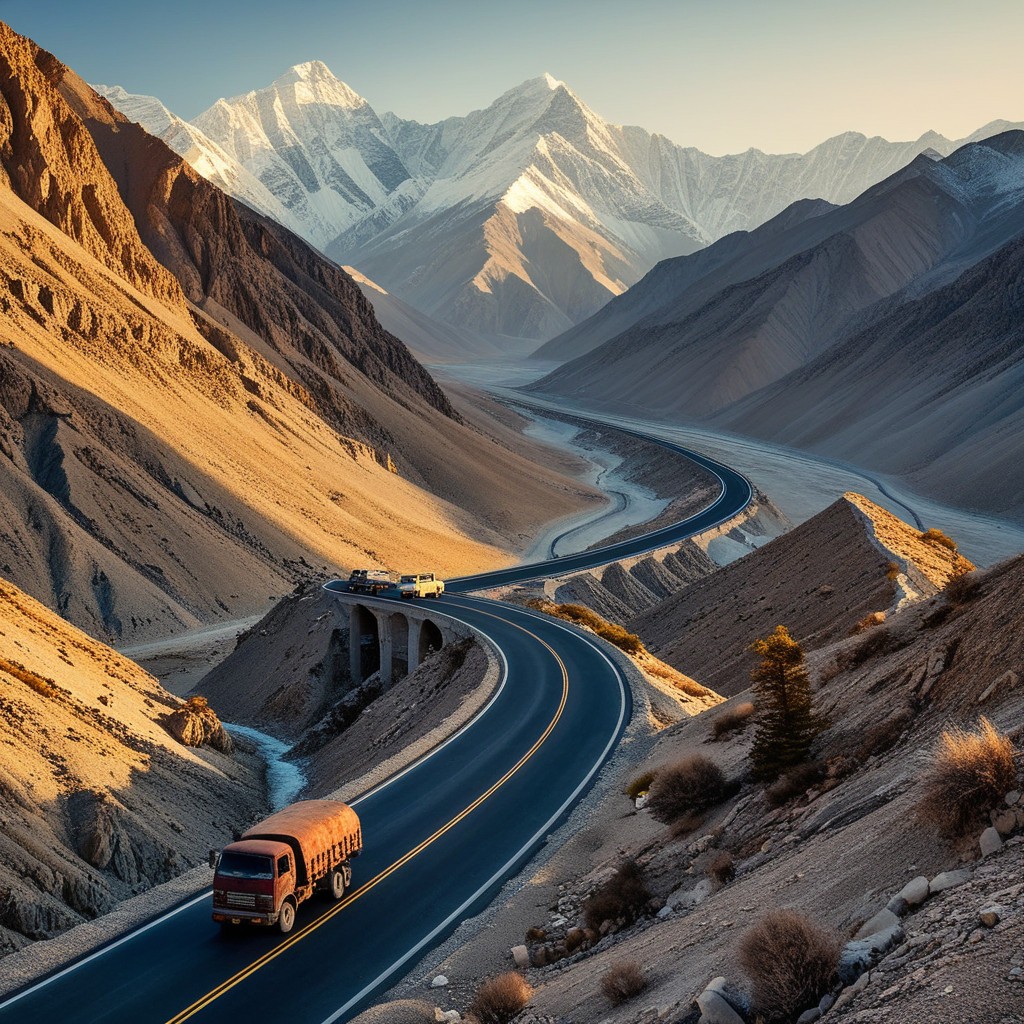
The Karakoram Highway: A Journey Through the “Eighth Wonder of the World
 The Karakoram Highway, often dubbed the "Eighth Wonder of the World," stands as a testament to human determination, engineering prowess, and the desire to connect two nations—Pakistan and China—through one of the most formidable landscapes on Earth. This extraordinary highway, stretching approximately 800 miles (1,300 kilometers), not only links these two countries but also traces part of the ancient Silk Road, making it a modern conduit through a historic trade route.
The Karakoram Highway, often dubbed the "Eighth Wonder of the World," stands as a testament to human determination, engineering prowess, and the desire to connect two nations—Pakistan and China—through one of the most formidable landscapes on Earth. This extraordinary highway, stretching approximately 800 miles (1,300 kilometers), not only links these two countries but also traces part of the ancient Silk Road, making it a modern conduit through a historic trade route.

Historical Significance and Construction
The idea of connecting China and Pakistan through a highway was born out of strategic and economic interests. The construction of the Karakoram Highway (KKH) began in 1959 and spanned over two decades, finally completing in 1979. Officially opened to the public in 1986, this monumental project was a joint effort by both nations. The endeavor required immense sacrifices, with an estimated 1,000 workers—both Pakistani and Chinese—losing their lives during the construction due to harsh weather, landslides, and the unforgiving terrain of the Karakoram mountain range.
The highway was built at a time when technology and equipment were not as advanced as today, making its completion even more remarkable. The engineers and workers faced extreme conditions, from severe winters to torrential rains and high-altitude challenges. The road cuts through some of the world's highest peaks, including the Karakoram, Hindu Kush, and the western Himalayas, making it the highest paved international road in the world.
Engineering Marvels of the Karakoram Highway
The Karakoram Highway is more than just a road; it is an engineering masterpiece that traverses rugged terrain, deep gorges, and towering mountain ranges. One of its most remarkable sections is the stretch through the Khunjerab Pass, the highest paved international border crossing in the world, sitting at an altitude of 15,397 feet (4,693 meters). The highway's path winds through some of the most challenging and breathtaking landscapes, including narrow mountain passes, vast glaciers, and deep river valleys.
Constructing the highway involved blasting through solid rock, navigating landslides, and building numerous bridges across fast-flowing rivers like the Indus and Hunza. The road's design took into account the region's extreme weather conditions, with significant portions requiring constant maintenance due to frequent landslides, rockfalls, and avalanches. The KKH remains a crucial lifeline for local communities, providing access to remote villages and facilitating trade and tourism between the two countries.
The Route: From Abbottabad to Kashgar
The Karakoram Highway starts in Abbottabad, Pakistan, and travels north through the beautiful valleys of Gilgit-Baltistan before crossing into China at the Khunjerab Pass. The Pakistani side of the highway is known for its stunning vistas, with scenic stops such as the Hunza Valley, Nanga Parbat (the world's ninth-highest mountain), and the Passu Cones, a series of jagged, cathedral-like peaks.
As travelers make their way into China, the landscape shifts to the stark beauty of the Xinjiang region. The journey concludes in the historic city of Kashgar, an ancient trading hub on the Silk Road. This route, which once facilitated the exchange of goods like silk, spices, and precious stones, now serves as a vital modern trade corridor, enhancing economic ties between China and Pakistan.
Tourism and Cultural Exchange
The Karakoram Highway is not just a route for goods and trade; it has become a bucket-list destination for adventure travelers and tourists seeking to experience its unique blend of natural beauty and cultural heritage. The region is home to a diverse array of cultures, including the Hunza, Wakhi, and Balti communities, each with its own language, traditions, and way of life. Tourists visiting the KKH can experience the hospitality of these local communities, taste traditional cuisines, and witness centuries-old customs.
The highway offers access to some of the most spectacular landscapes in the world. For mountaineers and trekkers, the region is a paradise, providing routes to iconic peaks like K2, Broad Peak, and Gasherbrum. The KKH also passes near several glaciers, such as the Baltoro Glacier and the Siachen Glacier, making it a gateway to some of the most remote and pristine areas of the Karakoram range.
Economic Impact and Modern Developments
The Karakoram Highway has significantly contributed to the economic development of the region. It facilitates trade and transport between Pakistan and China, providing a crucial link for the China-Pakistan Economic Corridor (CPEC), a flagship project under China's Belt and Road Initiative. This strategic partnership has led to the expansion and upgrading of the KKH, making it a key artery for transporting goods between the two countries.
Recent upgrades have transformed sections of the highway into a modern, high-speed road, improving connectivity and reducing travel time. The development has boosted tourism, allowing more visitors to explore the natural wonders of the region. Small businesses, such as roadside cafes, guesthouses, and tour operators, have flourished, providing income and job opportunities for local communities.
Challenges and Preservation Efforts
Despite its many benefits, the Karakoram Highway faces ongoing challenges. The region's unstable geology makes the road susceptible to landslides, earthquakes, and seasonal flooding. The Attabad Lake disaster in 2010, caused by a massive landslide, submerged a 22-kilometer stretch of the highway, creating a natural lake and cutting off access to the road. This event highlighted the vulnerability of the KKH to natural disasters, prompting efforts to enhance its resilience and safety.
Preservation of the highway's surrounding environment is another concern. The increase in traffic and tourism has led to environmental degradation in some areas. Efforts are underway to promote sustainable tourism and protect the unique ecosystems along the route. Local and international organizations are working together to conserve the region's natural beauty and cultural heritage, ensuring that the Karakoram Highway remains a marvel for future generations to experience.
Conclusion
The Karakoram Highway is more than just a road; it is a symbol of human endurance, a bridge between cultures, and a gateway to some of the most awe-inspiring landscapes on the planet. Its construction was a monumental feat, overcoming natural and logistical challenges to connect two countries and revitalize an ancient trade route. Today, it stands as a vital artery for trade, tourism, and cultural exchange, continuing to shape the lives of those who live along its path.
Whether you are an adventure traveler seeking the thrill of exploring remote mountain valleys, a history enthusiast tracing the footsteps of ancient traders, or simply someone who appreciates the raw beauty of nature, the Karakoram Highway offers an unforgettable journey through the heart of one of the world's most remarkable regions. It is indeed a wonder of the modern world, where the past and present converge in an epic display of nature's grandeur and human ingenuity.
Copyright © 2025 Amazing Stories. All rights reserved.